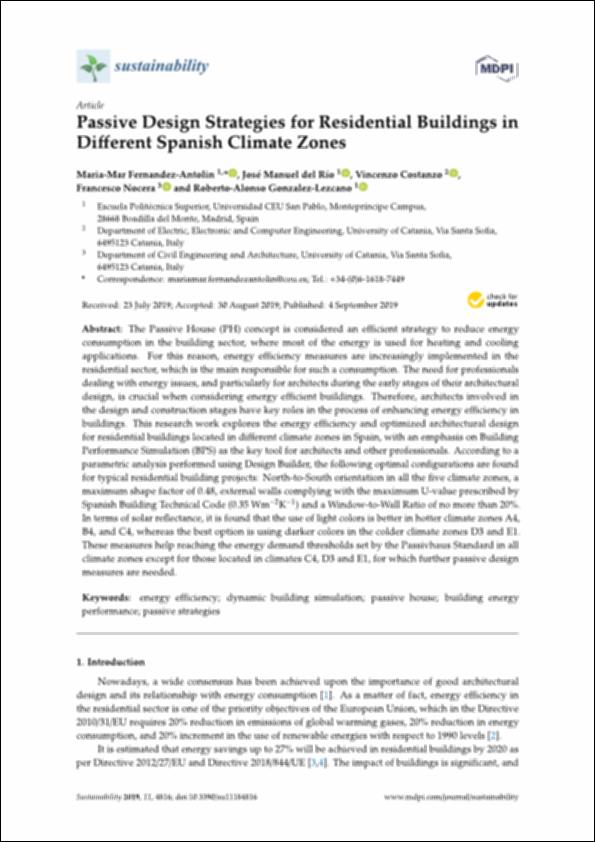Please use this identifier to cite or link to this item:
http://hdl.handle.net/10637/14597Passive Design Strategies for Residential Buildings in Different Spanish Climate Zones
| Title: | Passive Design Strategies for Residential Buildings in Different Spanish Climate Zones |
| Authors : | Fernández Antolín, María Mar Del Río Campos, José Manuel Constanzo, Vincenzo Nocera, Francesco González Lezcano, Roberto Alonso. |
| Keywords: | Energy efficiency; Dynamic building simulation; Passive house |
| Publisher: | MDPI |
| Citation: | Fernandez-Antolin, M.-M.; del Río, J.M.; Costanzo, V.; Nocera, F.; Gonzalez-Lezcano, R.-A. Passive Design Strategies for Residential Buildings in Different Spanish Climate Zones. Sustainability 2019, 11, 4816. https://doi.org/10.3390/su11184816 |
| Abstract: | The Passive House (PH) concept is considered an e cient strategy to reduce energy consumption in the building sector, where most of the energy is used for heating and cooling applications. For this reason, energy e ciency measures are increasingly implemented in the residential sector, which is the main responsible for such a consumption. The need for professionals dealing with energy issues, and particularly for architects during the early stages of their architectural design, is crucial when considering energy e cient buildings. Therefore, architects involved in the design and construction stages have key roles in the process of enhancing energy e ciency in buildings. This research work explores the energy e ciency and optimized architectural design for residential buildings located in di erent climate zones in Spain, with an emphasis on Building Performance Simulation (BPS) as the key tool for architects and other professionals. According to a parametric analysis performed using Design Builder, the following optimal configurations are found for typical residential building projects: North-to-South orientation in all the five climate zones, a maximum shape factor of 0.48, external walls complying with the maximum U-value prescribed by Spanish Building Technical Code (0.35 Wm2K1) and a Window-to-Wall Ratio of no more than 20%. In terms of solar reflectance, it is found that the use of light colors is better in hotter climate zones A4, B4, and C4, whereas the best option is using darker colors in the colder climate zones D3 and E1. These measures help reaching the energy demand thresholds set by the Passivhaus Standard in all climate zones except for those located in climates C4, D3 and E1, for which further passive design measures are needed. |
| URI: | http://hdl.handle.net/10637/14597 |
| Rights : | http://creativecommons.org/licenses/by-nc-nd/4.0/deed.es |
| ISSN: | 2071-1050 |
| Issue Date: | 4-Sep-2019 |
| Center : | Universidad San Pablo-CEU |
| Appears in Collections: | Escuela de Politécnica Superior |
Items in DSpace are protected by copyright, with all rights reserved, unless otherwise indicated.


